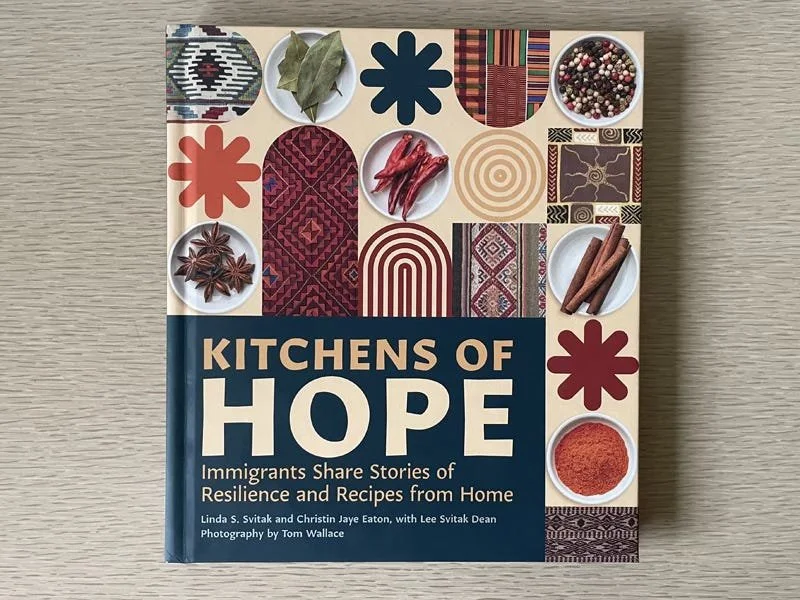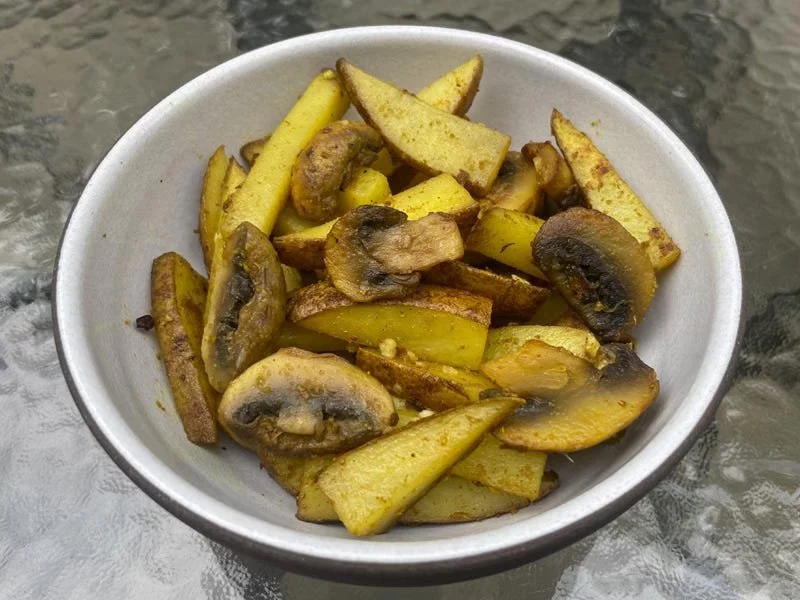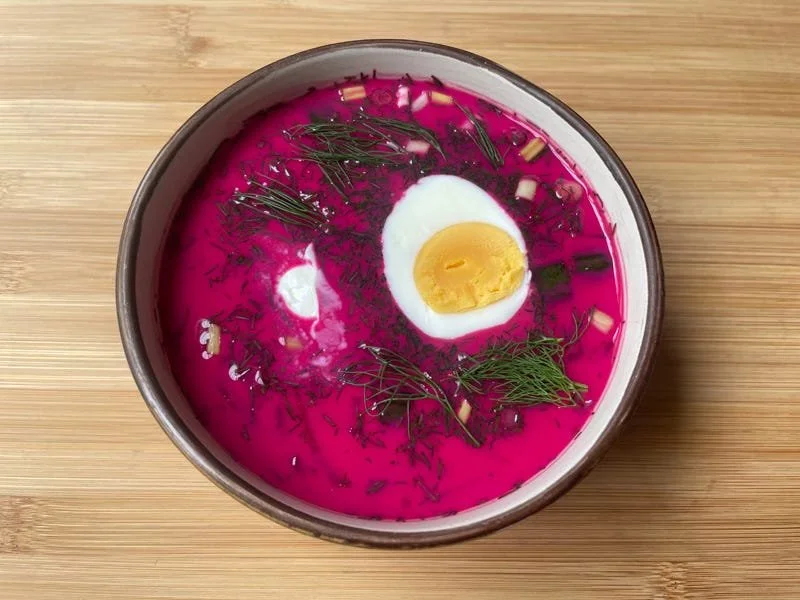FOOD FOR THE JOURNEY
In Kitchens of Hope, recipes help tell the stories of immigrants to the United States
By Stacy Brooks
This story was created by our partners at the Heavy Table, a weekly culinary newsletter dedicated to covering the best food and drink of the Upper Midwest. Back them on Patreon to receive four distinct email newsletters focused on dining, the restaurant business, spirits, and home cooking: http://www.patreon.com/heavytable
Stacy Brooks / Heavy Table
Kitchens of Hope begins with a forward by contributor Loan Huynh, recounting her harrowing escape from Saigon at age five as the city fell to North Vietnamese troops. Her family made their way to the beach, where her father begged nearby ships to come back and take his four small children, even if there wasn’t space for him and his wife. One captain was so moved by the plea that he sent a small boat to transport the entire family to his ship. Thanks to the captain’s decision, the family made it to safety and eventually settled in the United States. Huynh went on to earn a law degree and volunteers with the Advocates for Human Rights, a Minnesota-based non-profit that provides free legal assistance to people seeking asylum, those in immigrant detention, and unaccompanied children.
Huynh’s story is an unorthodox way to open a cookbook, but it’s the perfect way to begin Kitchens of Hope. The book is less a cookbook than an anthology of over three dozen immigration stories, accompanied by 50-plus recipes.
“Initially, we had a tight focus on the recipes,” says co-author and former Star Tribune Taste section editor Lee Svitak Dean. She explains that the project was conceived of as a cookbook with recipes from immigrants connected to the Advocates organization. The book’s other co-authors, Linda S. Svitak (Dean’s sister) and Christin Jaye Eaton, are attorneys who have volunteered with the Advocates, and Dean was brought into the project due to her food writing expertise.
“I wanted to have some background information on the immigrants so that I had something to use for context for a headnote. Something more minor was sort of what I had in mind,” Dean continues. “Linda and her colleague Christin started coming back with longer stories from the individuals, and as we were looking at those, it just seemed to me that those stories were so compelling that they needed a larger footprint.”
The stories span the globe—contributors hail from countries including Liberia, Peru, Mexico, Afghanistan, Greece, Russia, Mongolia, and the Democratic Republic of the Congo. Some immigrants came to the U.S. to escape war, violence, and persecution; others came to pursue higher education or start a business. The stories and recipes are arranged thematically, rather than geographically or by meal course, so a Hyderabadi Lamb dum Biryani recipe from India and a Eight-Treasure Rice Cake from China are grouped together under “Celebration.” Other themes include resilience, hope, opportunity, justice, and community.
“Individual stories are so incredibly important,” says Dean. “A story about many, many people in need does not resonate in quite the same manner as seeing the single photo of the single individual. That really was the driving force for the project.”
Most stories are accompanied by a portrait photo of the contributor, with some familiar faces from the Twin Cities food scene: José Alarcon (formerly of Popol Vuh, Centro, and Vivir), Gus and Kate Romero (Nixta), Stine Aasland (Nordic Waffles), and Yia Vang (Vinai). However, most of the contributors are home cooks without a public profile, underscoring how every immigrant to the U.S. has their own story to tell, often a complex and fascinating one.
The story sections are a compelling read—when I first got the book, I intended to skim through it, reading a few stories to get a feel for the tone. Instead, I found myself reading nearly every story beginning to end, and then retelling many of them to my husband over dinner.
But what about the recipes? They run the gamut from simple and accessible to novice cooks, like sheet pan chicken and three-ingredient, no-bake coconut cookies, to elaborate projects with multiple sub-recipes, like pupusas with three different fillings and a scratch masa dough, plus tomato sauce and a cabbage slaw as accompaniments.
“Some of the recipes had no written form until we wrote them down,” says Dean, noting that in those situations, she would join the contributor in the kitchen and take notes as they cooked. Some recipes needed to be translated, and others had to be written in a standardized form that would make sense to an American home cook.
“The work with the recipes was incredibly intense and that took a bigger chunk of time than I would normally have expected, just because we're dealing with different cooks, different methods, different ingredients, and different languages,” she explains. In total, the project took about four years.
I made two recipes from the cookbook, starting with Holodnik (Summer Beet Soup) contributed by Alena Levina, who immigrated to the U.S. from Belarus over twenty years ago and works in IT, as well as volunteering as a Russian translator for the Advocates.
The Holodnik recipe was easy to follow (see below): basically you boil beets; peel and grate them; combine the beets with kefir, onion, fresh dill, and cucumbers; and let everything sit in the refrigerator for several hours. I garnished the finished soup with more fresh dill, hard boiled eggs, and sour cream. For a recipe with relatively few ingredients, there’s a lot going on, in a delightful way: the soup is tangy, earthy, and herbal, with some great crunch from the cucumbers and a silkiness from the sour cream and kefir. Photos don’t do the vivid pink hue justice—it might be my new favorite color.
Stacy Brooks / Heavy Table
The second recipe I made was contributed by Rashmi Bhattachan, the Nepal-born co-founder of Gorkha Palace, MomoDosa, and Thaliwala Kitchen. Her family recipe for Chyau Tarkari (Mushroom Curry with Potatoes), was easy to pull together—the most hands-on step was slicing potatoes and mushrooms. The turmeric, cumin, coriander, and timur peppercorn spice profile had a warmth that would make this satisfying in winter, but the citrusy notes of the peppercorns and the dash of lemon juice also made it a great patio meal. My only (very minor) quibble is that my cooking time was several minutes longer than the recipe specified.
Anyone who has walked down Lake Street in Minneapolis or University Avenue in St. Paul knows the culinary richness that immigrants bring to our communities, and the recipes that I cooked from Kitchens of Hope certainly underscore that. But what makes this book truly special is the richness of the stories behind the recipes, highlighting and honoring the immigrants that help make our country great.
Kitchens of Hope, By Linda S. Svitak, Christin Jaye Eaton, and Lee Svitak Dean, University of Minnesota Press | 240 pages | June 17, 2025, $29.95
Stacy Brooks / Heavy Table
HOLODNIK (SUMMER BEET SOUP)
Serves 6
3 to 4 eggs, for garnish
1 1⁄2 pounds red beets (3 large or 8 small)
1 quart plain, whole-milk kefir, or buttermilk
2 teaspoons salt
1 teaspoon granulated sugar
1 small onion or 3 green onions, thinly sliced
1 bunch fresh dill, chopped, or 1 tablespoon dried, and more fresh dill for garnish
3 to 4 small cucumbers, diced (1 1⁄2 to 2 cups; see Note)
Sour cream, radishes, or croutons, for garnish
TO MAKE HARD-COOKED EGGS: Place the eggs in a small pan, cover with water, and bring to a boil over medium-high heat. Remove the pan from the heat, cover the pan, and let sit for 15 minutes. Drain the water and add cold water, repeating until the eggs have cooled. Refrigerate until ready to use.
TO MAKE THE SOUP: Scrub the beets and cut off the greens (you can save the greens for another dish). Place the beets in a pot, cover them generously with water, and bring to a boil over medium-high heat. Cook the beets until just soft, about 30 to 40 minutes. Drain and discard the water and let the beets cool. To peel them easily, push firmly near the top end of the beet and the skin should slide off. You may want to use kitchen gloves to keep your fingers from getting stained.
In a large bowl or pot, combine the kefir (or buttermilk) with 5 cups water. Grate the beets (there should be about 2 cups) and add to the kefir mixture. Add salt and sugar, then the onions, dill, and cucumbers. Cover and refrigerate for several hours.
TO SERVE THE SOUP: Divide the chilled soup into bowls. Garnish with fresh dill, a dollop of sour cream, radish slices, and/or croutons. Peel the hard-cooked eggs and slice them in half. Garnish each bowl with half of an egg.
NOTE: Plan ahead because this soup definitely improves if it is refrigerated for at least several hours before serving. Hard-cook the eggs in advance, if using for a garnish. For the cucumbers, peel the skins if they are too thick. Alena suggests that small cucumbers with thinner skins, usually available only at farmers markets, are preferred. “They’re so crunchy, I feel like they make this dish better.”
Reprinted from Kitchens of Hope: Immigrants Share Stories of Resilience and Recipes from Home by Lee S. Svitak and Christin Jaye Eaton, with Lee Svitak Dean; photography by Tom Wallace. Published by the University of Minnesota Press. Copyright 2025 by Linda S. Svitak, Christin Jaye Eaton, and Lee Svitak Dean. Photographs copyright 2025 by Tom Wallace. All rights reserved. Used by permission.



